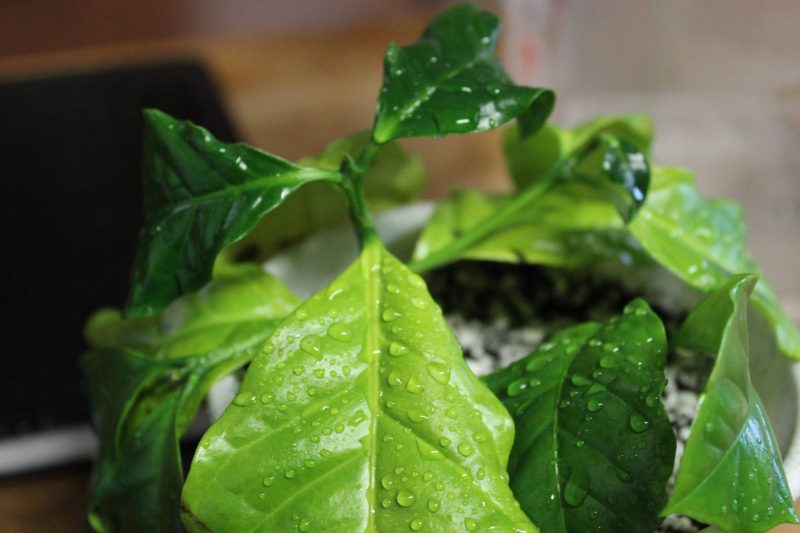Hundreds of millions of people around the world every day drink a fragrant drink, known to mankind since time immemorial, and Europeans - from the XVII century. It will be about coffee, or rather, how to grow a coffee tree at home. Indeed, in reality, this is not so difficult, since coffee requires almost the same attention as citrus fruits, which grow well on window sills.
Material Content:
Species and varieties
The coffee tree belongs to the madder family, numbering more than 5 thousand species.

At home, three varieties are mainly grown:
- Arabica It is a compact tree, which under good growing conditions can reach 5 m in height. The leaves in shape resemble an elongated ellipse, which has a dark olive hue. Inflorescences of this variety are collected in a bouquet, in diameter are about 2 cm. Their size may be larger, it all depends on the growing conditions. Arabica fruit is presented in the form of berries resembling round beans. They begin to ripen, after 7 - 8 months from the moment of pollination of the plant. When ripe, they have a light burgundy hue.
- Dwarf Nana. This is a tree whose height is only 85 - 100 cm. This variety bears fruit well at home. The tree is shaped by pinching its tops and trimming the shoots. The leaves of this variety are glossy and oblong. The shape of the flowers resembles jasmine, but they are smaller. The plant blooms for 4 years of life.
- Liberian variety. It features a small crop. The tree has a pyramidal shape, its height is from 6 to 12 m.This indicator depends on growing conditions and timeliness of pruning. The leaves are very large, leathery and oblong, up to 40 cm long. The ripened fruits are large, have an orange or scarlet hue, their size is 3 cm in length and 1.5 cm in width.
Coffee tree: cultivation features

To grow a coffee tree at home, you do not need any professional skills to work with exotic plants, but just a little zeal and attention to your green pet. If you satisfy the demands of the coffee tree and feed it in a timely manner, then the first flowering can be achieved in 7 - 10 years.
Home Care

How to care for a coffee tree:
- The plant needs good diffused lighting, moderate watering and periodic top dressing.
- Coffee is a fast-growing tree. Even formed in the form of a bush, it can reach a height of 1.2 - 1.5 m in 10-12 years. But to keep it within these limits is a perfectly feasible task. It is only necessary to cut it off in a timely manner.
Temperature features, lighting, humidity
The coffee tree is one of the few home exotic crops that does not need a cold wintering. The optimum temperature for its growth and development is +20 ... +22 degrees. In winter, cool down to + 17ºС is permissible. However, in cold weather, the level of air humidity must be taken into account.

- Do not place a coffee tree close to radiators.
- Also on hot summer days and during the winter, it should be sprayed from the spray gun 1 to 2 times a day.
- In spring, when neither the summer sun nor heating systems dry the air, this is not necessary, but desirable.
Important! Coffee loves diffused, but bright light, so placing it on western or eastern windows is an ideal option for a tree.
Soil requirements
The coffee tree loves neutral or slightly acidic soils. The ideal soil for it consists of 2 parts of turf and 2 parts of peat land, as well as one part of coarse sand.
Watering and feeding
The coffee tree is watered sparingly as the earthen coma dries. Neither dryness nor gulf of the root system should be allowed.

If the goal is to achieve flowering and fruiting from the coffee tree, then during the warm season it is fed 3-5 times. The first top dressing can be done in March, and the last in October.
- In spring, there should be a slight bias towards nitrogen in the nitrogen-phosphorus-potassium balance.
- In summer, approximately the same concentration of all elements is important.
- And in September - October it is advisable to introduce more potassium.
How to transplant a coffee tree?
Indoor plant coffee tree in his youth needs an annual transplant. It is important to choose a pot that is not much larger than the previous one. The best option is a container with a diameter of 2 - 5 cm larger than the previous one. At the bottom there should always be a layer of drainage in the form of expanded clay, pebbles or gravel.
Cropping and shaping the crown
A coffee tree is shaped like a bush. To do this, at the end of winter, the annual plant is shortened by 30 - 50%. In the spring it begins to branch actively. Next spring, each branch is shortened by 20 - 40%, depending on the strength of its growth - fast-growing pruning is stronger. The shoots growing inside the crown and too weak branches are also removed.
Propagation of a houseplant
At home, almost the only available way to propagate a coffee tree is to sow the seeds. Cuttings are used less frequently for two reasons: a low percentage of successful rooting and difficulties in obtaining material.
Cuttings
Possible difficulties when using cuttings:
- Search for cuttings. The export of planting material from other countries is complicated by their laws. An obstacle is also the rules of the recipient country, which require phytosanitary certificates for any plants and their parts when crossing the border.Of course, no one will write such a certificate on a stalk of a coffee tree. Therefore, the only way to get a coffee sprig is to find another grower who already has an adult plant.
- The rooting process. Alas, even under favorable conditions, the likelihood that the stalk will give roots is about 50%.
Conditions for rooting the cuttings:
- Coarse-grained sand, or vermiculite or perlite, or a mixture of sand with vermiculite or perlite can serve as a substrate for grafting coffee. It is poured into a shallow dish with drainage holes, moderately moisturized, lightly sprayed with Fitosporin to kill pathogenic fungi.
- The stalk can be about 10 cm in size. The lower leaves are removed from it, and the upper ones are either left if they are not large, or they are shortened with scissors 2 times if the surface of the leaf blades is large. The bottom cut can be either straight or at a slight angle, but most importantly, it is perfectly flat. If in doubt, it can be trimmed with a sharp blade.
- Cuttings are buried in a substrate by 1 cm and covered with plastic wrap or mini-greenhouse. It is necessary to ensure that the shelter is airtight: after 12 to 16 hours, drops should condense on its walls. If there is no condensation, the greenhouse is leaking.
- Once every 5 to 7 days, the shelter is removed for several minutes in order to aerate and is put on again.
- It is recommended to provide the cuttings with a weak soil heating. The main thing is not to overdo it! Usually, for this purpose, the structure is placed on central heating batteries, laying something thick under it, like a book or several layers of fabric. Earth should not overheat. We need to ensure that it becomes literally several degrees warmer than the environment.
Important! Roots usually appear after a month, but replanting cuttings from sand to soil is better after another 2 weeks, when the root system grows a little.
Seed propagation
Propagation of coffee seeds is also not easy. The main factor preventing this is the rapid loss of germination after seed collection. They should be sown as soon as possible, preferably within a week after collection, because in a month from a few 100 seeds sown, only a few will emerge. But where to get fresh planting material?
Here, only two options are possible: either picking fruit in another country immediately before departure and sowing immediately upon arrival home, or searching for a grower who, at home, has achieved fruiting of the coffee tree.
Is it possible to purchase coffee seeds in specialized stores for lovers of room exotic? Life shows what is possible. But even if you sow them immediately after purchase, you should not rely on great germination: 1 to 2 pieces can emerge from the entire batch.
Features of seed propagation:
- Sow the seeds in a container with a depth of 15 - 25 cm.
- Coffee loves light soil made up of 2 parts of turf, 2 parts of peat soil (suitable peat soil is suitable) and 1 part of sand.
- Grains are laid on the surface with a flat part and 1 - 2 cm of soil are sprinkled.
- The containers are covered with a plastic bag and kept at room temperature. Seedlings can be expected in 4 to 8 weeks.
Important! Ventilate the crops every 2 to 3 days, removing the film for 3 to 5 minutes.
Pests, diseases and methods of dealing with them
With proper care, the coffee tree is rarely affected by diseases and pests. But mistakes in caring for coffee lead to leaf necrosis when they are covered with brown spots and dry.
Possible causes of this phenomenon:
- Gulf of the tree in the cold season, resulting in decay of the root system.
- Overdry of an earthen coma, most often occurring in the summer.
- Sudden temperature changes.
- Acute lack of phosphorus and potassium in the soil.
Very rarely, coffee is affected by a scab and a spider mite.The first can be removed with the help of the drug "Actara", and the second pest - "Fitosporin" or "Bitoxiballicin."
Those who love coffee drinks should definitely try to grow a coffee tree at home. After all, the only real difficulty is plant propagation, and the rest is not so troublesome. In reliable and caring hands, the coffee tree will delight its owner with beautiful flowering and even fruiting!












